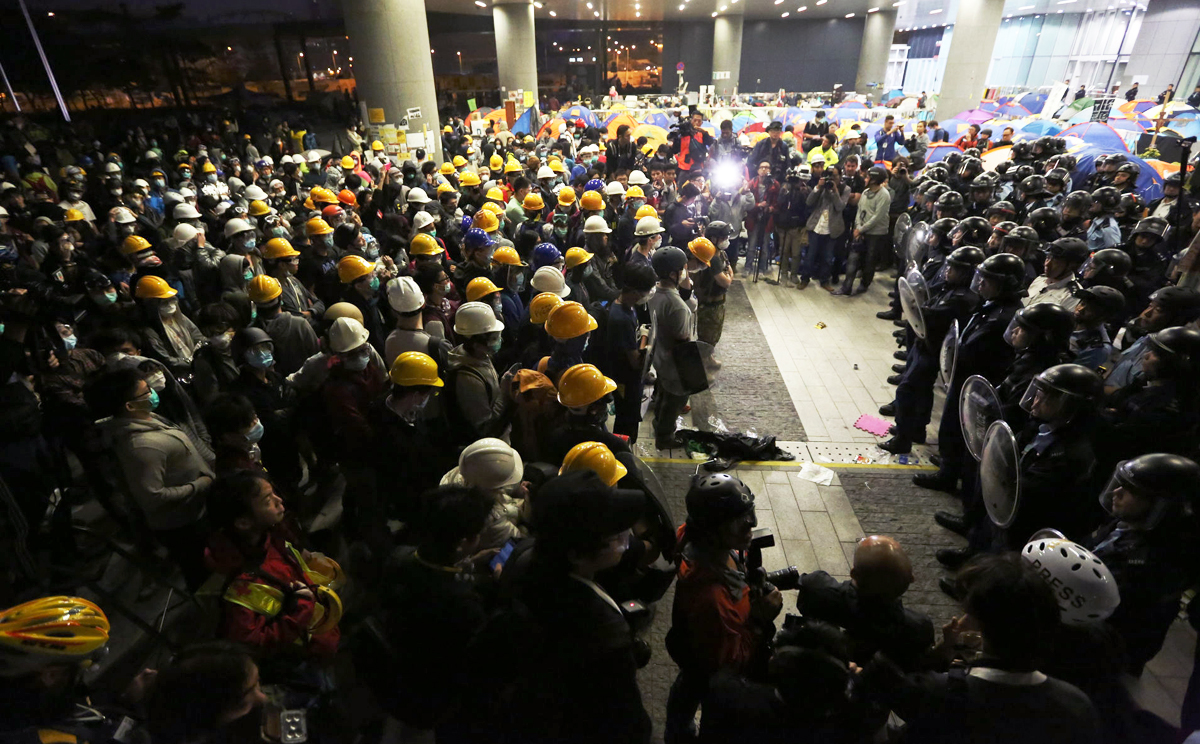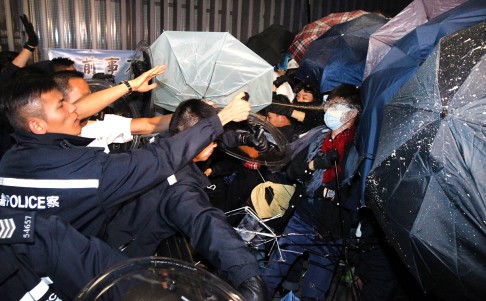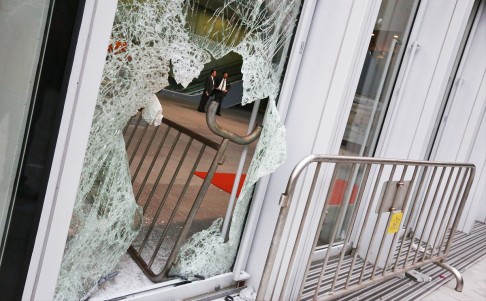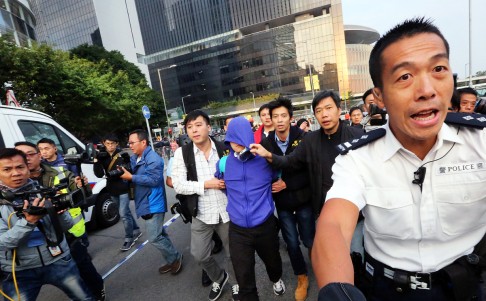Occupy Central
Occupy Central is a civil disobedience movement which began in Hong Kong on September 28, 2014. It calls on thousands of protesters to block roads and paralyse Hong Kong's financial district if the Beijing and Hong Kong governments do not agree to implement universal suffrage for the chief executive election in 2017 and the Legislative Council elections in 2020 according to "international standards." The movement was initiated by Benny Tai Yiu-ting (戴耀廷), an associate professor of law at the University of Hong Kong, in January 2013.
OCCUPY CENTRAL - DAY 53: Full coverage of the day’s events
Britain rules out banning tear gas exports to Hong Kong
PUBLISHED : Wednesday, 19 November, 2014, 3:35am
Britain will not block sales of tear gas to Hong Kong following a review of its export policy after gas was used against Occupy Central protesters in September.
In a written submission to British lawmakers on Monday, Foreign Office minister Hugo Swire said there was no proof that the gas deployed by police in Admiralty on September 28 had come from Britain.
"After carefully reviewing one current licence, the government has decided it will not be revoked on the basis that it does not contravene the consolidated criteria" for export licences, Swire wrote.
The review was launched after Hong Kong police used 87 tear gas canisters in an unsuccessful attempt to disperse pro-democracy protesters at the start of the Occupy campaign.
Swire's comments echo those of Britain's Business Secretary Vince Cable, who said last month that exports would continue.
In a written reply to questions from a committee of British lawmakers on arms exports, Cable said: "The foreign secretary has advised me that the use of tear gas by the Hong Kong police was an 'uncharacteristic' response at an earlier stage of the protests … and it was not indicative of a wider pattern of behaviour."
Official records show that since 2011, Hong Kong's Government Logistics Department and police bought at least 14,000 rounds of tear gas from British supplier Chemring. The sales were worth HK$13.8 million.
Yesterday, Britain's Department for Business, Innovation and Skills said applications for the sale of tear gas were approved based on international criteria and would be withdrawn if they were no longer met.
A spokesman said the department welcomed a pledge by the Hong Kong police to exercise maximum tolerance, adding: "We have consistently called on all sides to ensure that the demonstrations are peaceful and in accordance with the law."
In 2011, Britain banned tear gas exports to Bahrain after it was used in a crackdown on democracy supporters.
This article appeared in the South China Morning Post print edition as Britain rules out banning tear gas exports to city
Violent clashes between protesters, police as masked crowds attempt Legco break-in
PUBLISHED : Wednesday, 19 November, 2014, 7:22am
Police arrested four men after dozens of protesters stormed the Legislative Council in Admiralty and clashed with officers in the early hours of Wednesday.
The surprise flare-up of violence, which led to the deployment of pepper spray and police baton-charging protesters, took place barely one day after a clearance operation had been carried out at one of the main pro-democracy protest sites in the district.
Three police officers were hurt.
The Legco meeting and Public Works Subcommittee meeting scheduled for Wednesday were cancelled hours after the clashes broke out.
At around 1am, a group of masked people, many of whom appeared to be teenagers, used metal barriers and various objects including broken bricks to try to crack open the glass doors outside the canteen at the Legco complex.
Lawmaker Fernando Cheung Chiu-hung, who had arrived at the scene earlier, tried in vain to stop them.
Scores of police officers carrying shields moved in shortly afterwards, deploying pepper spray to fend off the attackers. Officers later spread out and guarded the entrance of the building after the crowd retreated.
Waving yellow, then red warning flags, police told the masked group not to charge again.
The stand-off continued for hours as more protesters flocked to the area and police reinforcements were called in.
At 3am, some protesters gathered again at the Legco's north entrance facing Victoria Harbour, with another group forming in the open area 20 metres away. More protesters continued to pour in. The crowds were very fluid and moved around. Most protesters wore masks and protective goggles.
As of 3am, the police said nobody had been formally arrested.
Some protesters said they were furious at seeing the barricades in the occupied area around Citic Tower being removed by bailiffs on Tuesday.
"We want to use this action to pass on our voices, across onto those over on the other side of the glass," said a protester, who refused to be named.
Another protester, who said she had been staying in the protest zone in Admiralty since the class boycott in September, said the "main stage" people, who organised the Occupy Central sit-in, were doing nothing and just waiting for the government to come clear them out.
"At least we need to fight to abolish functional constituencies ... Universal suffrage is a far-off dream, but this we need to fight for because it's the first step," she said. Not all "pushing-forward" actions were bad, she insisted.
Both said they were there when the glass doors in the Legco complex were broken by rocks, and said there were three people still inside the building.
Cheung, who tried to stop the protesters from smashing the glass doors, also said there might be at least one protester who had snuck into the complex.
“What they [the masked attackers] did was not helpful to the matter as a whole,” he said.
Cheung was not injured but at least one suspected blood stain was seen on his shirt. He said he suspected someone might have been cut by broken glass.
At 4.30am, protesters regrouped and clashed with police again. Officers used pepper spray and baton-charged the crowd, who were again forced to retreat, with dozens mounting a wall and fleeing into the adjacent Tamar Park.
Earlier on Tuesday night, at around 10pm, dozens of masked people attempted to storm the Legislative Council through the side gate but could not enter the building because the gate was locked. Some of them then suggested occupying Lung Wo Road which is adjacent to the complex, before they were stopped by other protesters at the site.
Some masked protesters claimed they were trying to obstruct the amendment to the copyright law that addresses the issue of user-generated content. This is, however, not on the agenda of the Legco meeting on Wednesday.
Federation of Students secretary-general Alex Chow Yong-kang said on Wednesday morning that storming Legco was pointless. He denied that the Occupy protests had gone out of control but admitted that there was "room for improvement" in coordinating among protesters.
Scholarism convener Joshua Wong Chi-fung said the protesters' action would endanger other demonstrators.
“In a civil disobedience campaign participants have to shoulder their legal responsibilities and ensure the safety of all other participants,” he said.
“Those storming the Legco and then leaving the scene immediately afterwards would pose danger to other protesters behind them.”
Eddie Lee, Jennifer Ngo, Danny Mok, Lai Ying-kit
Hong Kong legislators propose three-metre fence to keep protesters at bay
PUBLISHED : Wednesday, 19 November, 2014, 2:54pm
The overnight storming of the Legislative Council complex yesterday prompted 41 pro-establishment lawmakers to support proposals to step up security measures, including installing a three-metre-high fence outside the building and seeking a court order to eject protesters.
But pan-democratic lawmakers object to the measures, saying a fence would keep people at a distance from the legislature and an injunction was inappropriate.
Andrew Leung Kwan-yuen, of the Business and Professionals Alliance, said security had to be strengthened to protect the estimated 1,000 people working in Legco when it is in session - 600 staff in the secretariat, 100 reporters and 300 councillors' assistants.
"Their safety should come first. The Occupy protests have caused safety and hygiene problems. We have asked Legco's legal advisers to study the possibility of an injunction," Leung said.
He cited a rule of the Legislative Council Commission that people using the demonstration areas outside Legco could only remain there for up to 48 hours at a time.
Leung noted that the council could also use the Powers and Privileges Ordinance that makes it a criminal offence to obstruct legislators on their way to and from the building and in the chamber. But he said be believed an injunction would be "more of a deterrent".
Jeffrey Lam Kin-fung, also from Leung's alliance, said erecting a three-metre fence at the Legco car park entrance and the adjacent members' entrance was "worth considering".
Legco President Jasper Tsang Yok-sing said the fence was among measures suggested by a security consultant in a review launched before Occupy Central began in late September, but that the commission had not made a decision on installing it.
"The Legco complex was not designed to cope with a deliberate attack to break in," he said yesterday.
Tsang denied reports that the proposed fence would "surround" the Legco building. The fence would remain open unless it was necessary to close it for safety reasons.
Tsang also said there was no plan to clear the protest area outside the council complex, and Legco's legal advisers would have to study the possibility of an injunction.
But the Civic Party's Ronny Tong Ka-wah, who is also a barrister, said an injunction would be hard to obtain because Legco was not a commercial organisation and it was the government, not the members of Legco, that owned the areas outside the building.
"The place outside is for public use and not for lawmakers' use. At the most, we only have inconvenience in that we can't drive our cars here."
Tong and all other pan-democratic lawmakers objected to erecting the fence, saying it would alienate the public, the very people legislators are supposed to represent and listen to.
This article appeared in the South China Morning Post print edition as 3-metre fence proposed to keep protesters at bay
Overwhelming majority of Hongkongers want Occupy protests to end: survey
PUBLISHED : Wednesday, 19 November, 2014, 9:50pm
Nearly 83 per cent of Hongkongers want the Occupy Central protests to stop, while more than two-thirds believe the government should clear the protest sites, a University of Hong Kong survey has found.
 Almost 55 per cent of 513 respondents interviewed by the university's public opinion programme on Monday and Tuesday said they opposed the civil disobedience movement, while 28 per cent supported it.
Almost 55 per cent of 513 respondents interviewed by the university's public opinion programme on Monday and Tuesday said they opposed the civil disobedience movement, while 28 per cent supported it.
And 82.9 per cent said the protests, now in their eighth week, should end, while 13 per cent said they should continue. Another 4.1 per cent replied "don't know/hard to say".
The survey findings were released a day after Dr Chan Kin-man, a co-founder of Occupy Central, urged protesters to consider ending their road blockades and instead refocus on winning the long-term support of the public.
More than 68 per cent of the respondents said the Hong Kong government should clear the protest sites, while 25.1 per cent said it should maintain the "status quo". Another 6.8 per cent said "don't know/hard to say".
The survey had a response rate of 65.9 per cent, a sampling error of plus or minus 4.4 percentage points and a confidence level of 95 per cent.
More than 11 per cent of the respondents said they had taken part in the protests, compared to 88.4 per cent who said they had not done so.
According to another survey by Chinese University's Centre for Communication and Public Opinion Survey from November 5 to 11, more than 67 per cent of 1,030 respondents believed the protesters should go home, while 14 per cent believed the opposite.
Dr Ma Ngok, a political scientist at Chinese University, said as the Occupy protests had dragged on for such a long time, some people who were sympathetic to its aims now disagreed with the continuation of the sit-ins without clear goals.
"Many occupiers joined in in the hope of protecting students. Student leaders find it difficult to withdraw from protest zones because they believe they owe a moral responsibility to those occupiers," he said. "The students think they shouldn't abandon the occupiers lightly."
This article appeared in the South China Morning Post print edition as 83pc say Occupy protests must end now
Six arrested after masked crowds smash Legco glass doors, clash with police
PUBLISHED : Wednesday, 19 November, 2014, 7:22am
Police on Wednesday strongly condemned a “mob” of protesters who stormed the Legco building last night, attempting to break in through a window, which they smashed using an iron barricade.
Hui Chun Tak, chief superintendent of Police Public Relations Branch, said that six men aged between 18 and 24 had been arrested for criminal damage and for assaulting police officers during the incident.
Three police officers were injured in scuffles at the scene and Hui said there may be more arrests pending further investigations.
Equipment belonging to the police also went missing last night’s clash – a baton, a helmet and two shields – and police urged people who knew their whereabouts to return the items to police.
Regarding the protest site in Mong Kok, Hui said police would assist bailiffs in carrying out the injunction order to remove barricades there and confirmed they had met with the plaintiff and bailiffs today to discuss how to implement the removals.
Hui said a large-scale confrontation could easily take place as many protesters of opposing camps have gathered tehre. A man aged 52 was arrested last night for common assault, Hui added.
The police urged people not be incited by radical individuals and urged protesters to remove the obstacles and leave the protest zone in an orderly and peaceful manner as soon as possible.
The surprise flare-up of violence, which led to the deployment of pepper spray and police baton-charging protesters, took place barely one day after a clearance operation had been carried out at one of the main pro-democracy protest sites in the district.
The Legco meeting and Public Works Subcommittee meeting scheduled for Wednesday were cancelled hours after the clashes broke out.
Watch: Clashes as alleged Hong Kong protesters attempt parliament break-in
At around 1am, a group of masked people, many of whom appeared to be teenagers, used metal barriers and various objects including broken bricks to try to crack open the glass doors outside the canteen at the Legco complex.
Lawmaker Dr Fernando Cheung Chiu-hung, who had arrived at the scene earlier, tried in vain to stop them.
Scores of police officers carrying shields moved in shortly afterwards, deploying pepper spray to fend off the attackers. Officers later spread out and guarded the entrance of the building after the crowd retreated.
Waving yellow, then red warning flags, police told the masked group not to charge again.
The stand-off continued for hours as more protesters flocked to the area and police reinforcements were called in.
At 3am, some protesters gathered again at the Legco's north entrance facing Victoria Harbour, with another group forming in the open area 20 metres away. More protesters continued to pour in. The crowds were very fluid and moved around. Most protesters wore masks and protective goggles.
Some protesters said they were furious at seeing the barricades in the occupied area around Citic Tower being removed by bailiffs on Tuesday.
"We want to use this action to pass on our voices, across onto those over on the other side of the glass," said a protester, who refused to be named.
Another protester, who said she had been staying in the protest zone in Admiralty since the class boycott in September, said the "main stage" people, who organised the Occupy Central sit-in, were doing nothing and just waiting for the government to come clear them out.
"At least we need to fight to abolish functional constituencies ... Universal suffrage is a far-off dream, but this we need to fight for because it's the first step," she said. Not all "pushing-forward" actions were bad, she insisted.
Both said they were there when the glass doors in the Legco complex were broken by rocks, and said there were three people still inside the building.
There is a split in the Occupy camp over whether protests should remain peaceful or not, said Kuroros Li, 23, who was among those who stormed Legco. He said that some demonstrators were wary of political parties using the Occupy movement to leverage support.
"I'm not afraid to say that we already disagree with most political parties; it's just that we wanted to unite at first, but that'll change after last night. We may go our separate ways," he said.
"Our aim is to attract Occupiers in Admiralty who still insist that peace can change everything, and not the people on the outside.
"When the clearances started yesterday, they were extremely cooperative and even helped move their stuff away, which felt strange to me: why are you playing along with the government?"
He said some protesters have talked about taking over government buildings and key locations, like Admiralty Centre and Lung Wo Road.
"It's not a matter of which government building or landmark we occupy, but if we do nothing, then we're just waiting for this movement to end," he said.
Lawmaker Cheung, who tried to stop the protesters from smashing the glass doors, also said there might be at least one protester who had snuck into the complex.
“What they [the masked attackers] did was not helpful to the matter as a whole,” he said.
Cheung was not injured but at least one suspected blood stain was seen on his shirt. He said he suspected someone might have been cut by broken glass.
Cheung called the protesters’ action a "dark spot" for the Occupy movement.
"The opposition will definitely use what happened last night to smear our entire movement, and that might deal us a fatal blow in a referendum," he said.
"For the past 50 days now, the government has remained an inaccessible wall and hasn't responded to very reasonable demands from citizens.
"I'm afraid this will give the government and pro-government lawmakers an excuse to put up more walls in Legco."
At 4.30am, protesters regrouped and clashed with police again. Officers used pepper spray and baton-charged the crowd, who were again forced to retreat, with dozens mounting a wall and fleeing into the adjacent Tamar Park.
Earlier on Tuesday night, at around 10pm, dozens of masked people attempted to storm the Legislative Council through the side gate but could not enter the building because the gate was locked. Some of them then suggested occupying Lung Wo Road which is adjacent to the complex, before they were stopped by other protesters at the site.
Some masked protesters claimed they were trying to obstruct the amendment to the copyright law that addresses the issue of user-generated content. This is, however, not on the agenda of the Legco meeting on Wednesday.
Federation of Students secretary-general Alex Chow Yong-kang said on Wednesday morning that storming Legco was pointless. He denied that the Occupy protests had gone out of control but admitted that there was "room for improvement" in coordinating among protesters.
Scholarism convener Joshua Wong Chi-fung said the protesters' action would endanger other demonstrators.
“In a civil disobedience campaign participants have to shoulder their legal responsibilities and ensure the safety of all other participants,” he said.
“Those storming the Legco and then leaving the scene immediately afterwards would pose danger to other protesters behind them.”
Eddie Lee, Jennifer Ngo, Danny Mok, Lai Ying-kit, Alan Yu
Britain rules out banning tear gas exports to Hong Kong
PUBLISHED : Wednesday, 19 November, 2014, 3:35am
Britain will not block sales of tear gas to Hong Kong following a review of its export policy after gas was used against Occupy Central protesters in September.
In a written submission to British lawmakers on Monday, Foreign Office minister Hugo Swire said there was no proof that the gas deployed by police in Admiralty on September 28 had come from Britain.
"After carefully reviewing one current licence, the government has decided it will not be revoked on the basis that it does not contravene the consolidated criteria" for export licences, Swire wrote.
The review was launched after Hong Kong police used 87 tear gas canisters in an unsuccessful attempt to disperse pro-democracy protesters at the start of the Occupy campaign.
Swire's comments echo those of Britain's Business Secretary Vince Cable, who said last month that exports would continue.
In a written reply to questions from a committee of British lawmakers on arms exports, Cable said: "The foreign secretary has advised me that the use of tear gas by the Hong Kong police was an 'uncharacteristic' response at an earlier stage of the protests … and it was not indicative of a wider pattern of behaviour."
Official records show that since 2011, Hong Kong's Government Logistics Department and police bought at least 14,000 rounds of tear gas from British supplier Chemring. The sales were worth HK$13.8 million.
Yesterday, Britain's Department for Business, Innovation and Skills said applications for the sale of tear gas were approved based on international criteria and would be withdrawn if they were no longer met.
A spokesman said the department welcomed a pledge by the Hong Kong police to exercise maximum tolerance, adding: "We have consistently called on all sides to ensure that the demonstrations are peaceful and in accordance with the law."
In 2011, Britain banned tear gas exports to Bahrain after it was used in a crackdown on democracy supporters.
This article appeared in the South China Morning Post print edition as Britain rules out banning tear gas exports to city






沒有留言:
張貼留言